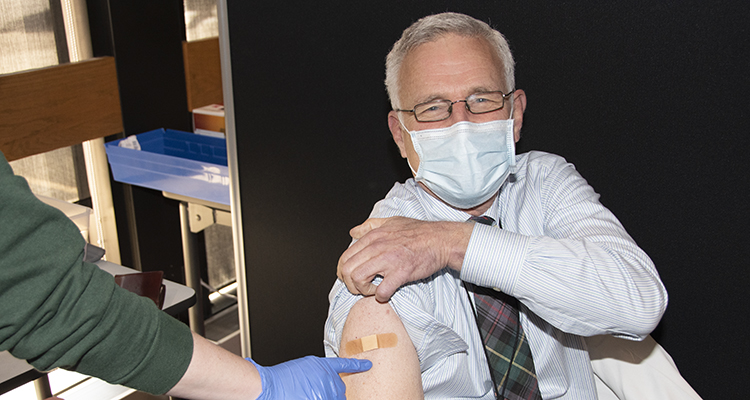 Dr. Seth Landefeld, Chair of the UAB Department of Medicine, receives his COVID-19 vaccination.
Dr. Seth Landefeld, Chair of the UAB Department of Medicine, receives his COVID-19 vaccination.
Concern: The vaccine was rushed in production. I don’t trust that it’s safe.
Response: Seth Landefeld, MD
It’s natural to wonder if the speed of vaccine development suggests that investigators, drug companies, or the government might have cut some corners. Here are three scientific facts about the rapid development of the Pfizer and Moderna vaccines.
1) Investigators followed ALL clinical trial protocols to rigorously test safety and effectiveness.
Our Food and Drug Administration mandates that vaccine research follow stringent guidelines for determining whether a vaccine works as intended, and whether people can tolerate the vaccine. Each study is developed in phases, where increasing numbers of participants are enrolled. Their reactions—both positive and negative—are documented. The Pfizer/BioNTech vaccine demonstrated through each phase that side effects were generally mild to moderate intensity and resolved within 24 hours; and it is 95% effective in preventing COVID-19 infections.
2) The Pfizer-BioNTech study enrolled more than 40,000 participants across 153 study sites in 6 countries.
The numbers of clinical trial participants for COVID vaccine research are extremely high, due to the widespread nature of this infection and high motivation to find a way to prevent COVID. Similarly, the Moderna vaccine trial enrolled 30,000 participants in their study across 99 testing sites. Moreover, the FDA will continue to evaluate the safety of the vaccine as it is administered across the country.
3) Vaccines based on messenger RNA have been around for a decade.
While this is the first time many of us will have the opportunity to receive a vaccine that is based on messenger RNA—rather than a protein or an inactivated form of the virus—vaccine researchers have been working with mRNA vaccines for 10 years. The premise is simple. As mRNA is taken up by muscle cells at the site of injection, these cells start producing the surface protein of the SARS-CoV-2 virus. The immune system recognizes the protein and reacts, producing antibodies that can recognize a potential SARS-CoV-2 infection and prevent COVID. Basically, the vaccine engages the body’s innate immune processes to generate protection from infection.
For a deeper dive into these issues, you can hear our resident Department of Medicine vaccine expert Dr. Paul Goepfert’s presentation at last week’s Medical Grand Rounds.
As always, stay tuned to #UABUnited and UAB Medicine for official updates on COVID safety and vaccination progress.
Note: This series is intended for those in our community who have reservations about getting “the shot.” These five articles from UAB Department of Medicine highlight a member of our DOM family, and how they have answered these commone concerns about COVID-19 vaccine for themselves and for their patients.